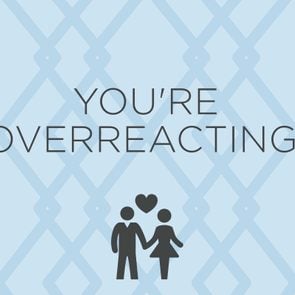How to Set Boundaries and Build Better Relationships
Updated: Jul. 25, 2024

If you feel like you don't have any more to give, it might be time to learn how to set boundaries at work, at home and in your relationships. Here, experts explain the steps to take.
Think of boundaries as mental, physical and emotional limits you put into place to protect yourself in relationships—you know, the list of the behaviors you will and won’t accept when interacting with others. Without boundaries, you’re constantly at risk of being walked all over by that overbearing friend, super-demanding boss, overstepping in-laws or significant others who want to make all the decisions, leaving you feeling resentful and burned out. Learning how to set boundaries is essential for building and maintaining healthy relationships.
“Boundaries are expectations and needs that help you feel safe and comfortable,” says licensed therapist Nedra Glover Tawwab, the New York Times bestselling author of Set Boundaries, Find Peace and Drama Free: A Guide to Managing Unhealthy Family Relationships. “It’s knowing when to say no and when to say yes. Creating healthy boundaries leads to feeling calm, loved and respected.”
Sounds ideal, right? In theory, yes, but if you’re unsure how to set boundaries in your life, you’re not alone: According to a 2022 YouGov survey, 49% of Americans (including 56% of women) identify themselves as people pleasers who have a hard time saying no and instead put others’ needs ahead of their own. If that’s you, don’t worry. You can start setting boundaries right now.
Ahead, Tawwab and Helene Lerner, author of Time for Me: Self-Care and Simple Pleasures for Women Who Do Too Much, share expert guidance and tips for how to set, communicate and maintain healthy boundaries with everyone in your life. They even explain what to do if someone crosses your boundaries. And believe me, it happens!
Get Reader’s Digest’s Read Up newsletter for more relationship tips, humor, cleaning, travel, tech and fun facts all week long.
About the experts
|
What are boundaries?
Boundaries are the framework that supports your relationships. A stronger framework makes for a stronger relationship, whether that’s with a romantic partner, family member, friend, boss, neighbor, co-worker or any other person in your life. “Boundaries create a relationship that is truly shared—it’s not just one person catering to another but an exchange, with two people having their needs met,” Lerner says.
Healthy boundaries are:
- Nonnegotiable
- Loving
- Empowering
- Kind
- Respectful
- A form of self-care
- Protective
- Rules you decide that govern your behavior
Healthy boundaries are not:
- Mean
- Combative
- Manipulative
- An excuse for rude behavior
- Rules you put on other people to control their behavior
Why you—yes, you—need boundaries

If you constantly feel like others ask too much of you and you’re reaching a breaking point, that’s a sign that your boundaries may be lacking (or missing). A big reason people don’t set or enforce boundaries? Fear.
“It takes courage for many of us to set healthy boundaries because we may be afraid that if we do, we’ll lose someone we care about,” Lerner says. So instead of standing up for yourself and possibly risking the relationship, you cave in. You think it’s better to sacrifice your needs to make the other person happy—no matter the toll it takes on you mentally or physically.
Sound familiar? If so, know that this pattern isn’t helping you or them. “If we are used to people-pleasing or acquiescing because of the fear of loss, then what were we really getting out of that relationship? Not a whole lot,” she says. “Do we really want someone who doesn’t respect our needs?” Instead, consider boundary-setting as part of your regular self-care routine and see how much your well-being improves.
Benefits of having boundaries
- A stronger sense of self and identity
- Reassurance that you’re in healthy relationships
- Less risk of being taken advantage of
- More confidence and less anxiety in relationships
- More authentic and honest communication
- Stronger trust
- Less exhaustion and burnout
- Clear expectations
Types of boundaries
Wondering how setting boundaries can do all that? It’s because there are six different types of boundaries that encompass all aspects of relationships. Below, you’ll find the boundaries you might set and ways someone might cross the line and violate your boundaries.
| Boundary | Violations |
| Physical | Standing too close or unwanted hugging, handshakes or other touch |
| Sexual | Molestation, assault or sexual jokes |
| Intellectual | Name-calling, yelling or ridiculing someone for what they believe |
| Emotional | Oversharing, gossiping or invalidating someone’s feelings |
| Material | Borrowing and not returning an item or returning borrowed items in worse condition |
| Time | Asking for free help, calling or texting too late, or overcommitting |
Each type of relationship may require you to set one or more types of boundaries. In exploring how to set boundaries with friends, for instance, you may need to create time, emotional or material boundaries. Setting boundaries at work may involve creating time, physical and emotional boundaries with colleagues.
“When something doesn’t feel right, create a boundary and communicate that boundary with others,” Tawwab says. Learning how to set boundaries in the different areas of your life can give you more agency, improve your mental health and self-confidence, and lead to more moments of joy instead of the dread of obligation.
How to set boundaries

OK, so how do you put those boundaries into place? The first step is to recognize where you need them. Then, communicate your needs by being polite but firm. Set expectations and end with the consequences for not respecting your boundaries. Here are some specific steps and tips from our experts on the best ways to set boundaries, plus scripts you can use in the process.
Tip 1: Decide where your line is
You can’t set a boundary if you don’t know what it is. Before you talk to the person you intend to set boundaries with, determine exactly what you are no longer able to put up with. “Be honest with yourself. What are you willing to tolerate?” Tawwab says. “Setting successful boundaries begins with you. Learn your capacity.”
Do this: Pick a clear line. For instance, say you need to set a time by which you absolutely need to leave work. Forget quiet quitting—you need to state your boundaries out loud to your boss. “If you need anything, I’ll be at my desk until 5 p.m., but then I do need to leave on time. I’ll be available for calls or emails starting at 8 a.m. the next morning, and I look forward to seeing you in the office again at 9.”
Tip 2: Role-play the conversation
You’ll need to have honest conversations when you’re setting boundaries, and this can be scary at first, especially for people who tend to avoid conflict. “If you are not used to setting boundaries, role-play with a trusted friend or practice in front of a mirror,” Lerner says. “When you do it out loud, it lessens the discomfort of a new behavior. You may feel less uneasy going into the real conversation.”
Do this: Ask a loved one to help you practice. Write down a short script for what you’d like to say, then practice saying it out loud with them until you don’t need your notes anymore. As you learn how to set boundaries and get more adept at it, the need for this practice will lessen. “Like any other muscle, the boundary muscle gets stronger the more you use it,” Lerner says.
Tip 3: Have the conversation

The time has come to say it loud and clear. “Verbally communicate your needs. Assertively state what you expect. This way, there is little room for misinterpretation,” Tawwab says. As tempting as it is, never do this over text message.
This conversation may feel intimidating, but that’s normal. “Step out of your comfort zone and do it!” Lerner says. “Yes, a new behavior doesn’t feel comfortable, but the reward after a hard-fought battle with fear is a new sense of self-respect.”
Do this: Approach it as a discussion, not a tirade, and you’ll lessen the chance that the other person will go on the defensive. When you are asking someone to refrain from making judgemental comments about your weight, for instance, you might say, “I have a concern about our relationship, and because I love and care about you so much, I want to discuss it with you. It makes me uncomfortable when you comment on my body size or what I’m eating, and I’m not willing to talk about those things anymore. If you bring it up, I’ll change the subject. We have so many other interesting things to talk about anyhow!”
Tip 4: Tell the truth
You may have been holding in all your gripes for a long time, so you don’t want to leave the boundary-setting conversation thinking about what you should have said. You don’t want to waste time beating around the bush, but you need to respect the other person’s feelings by saying things in a gentle manner while still being upfront and truthful about your needs.
“When we tell the truth to the people in our lives, we allow them to know the ‘real’ us,” Lerner says. “If we hold things in, we start resenting the people we care about the most, so it is better to take the risk and draw clear lines when we feel they are necessary or beneficial.”
Do this: Maybe you have a parent who is always trying to tell you how to parent your children and criticizes you when you do things differently. Your boundary-setting conversation might include this: “Mom, I really respect your years of parenting wisdom, and I’m grateful for the concern you have for my daughter. However, I am her mother and understand what she needs. Please don’t correct my parenting decisions, give unsolicited parenting advice or go behind my back. If you do, then we’ll end the visit and leave.”
Tip 5: Use “I” language

During the conversation, your language should reflect the fact that these are your personal feelings. “Talk in the first person, rather than putting the onus entirely on the other person,” Lerner says. “This will minimize feelings of defensiveness while ensuring that your priorities are being fully vocalized.”
She offers a few examples of using “I” language while setting boundaries: “When [blank] happens, I feel uncomfortable,” “I am proposing we do [blank] this way,” “I don’t think this is feasible, because [blank].”
Do this: If you have a friend who consistently cancels plans on short notice, you can try saying something like, “When you cancel plans at the last minute, I feel really hurt and disappointed. I want to feel like a priority in your life, and it really inconveniences me. If you do this again, I’ll need to limit the time I spend with you.” Ignore any guilt about what the other person might feel—this is about you and not being taken for granted.
Tip 6: Set priorities
Although you should have a clear idea of your boundaries, you can leave yourself some wiggle room if you think you’ll get pushback. “Figure out what your priorities are and find clarity on what is important to you: what you must have, what would be nice to have and what doesn’t matter that much,” Lerner says. “Must-have is nonnegotiable. Would-be-nice can be negotiated, but stay true to yourself! Doesn’t-matter-that-much is exactly as it sounds; that’s your currency to ensure you get all your must-haves.”
Do this: Decide what you’re willing to negotiate in advance. For example, when setting boundaries at work, if you tell your boss you’re doing a digital detox and no longer plan to check emails on the weekend, you might be able to negotiate a one-time check-in if you’re OK with it—but that’s it. Try this: “I’d prefer not to check my emails after Friday at 5 p.m., but I can see that being reachable is really important to you. How about I check my email once, Saturday afternoon, and anything else can wait until Monday?”
Tip 7: Be flexible

Having flexibility refers to your own needs, which may alter over time. After all, your boundaries aren’t set in stone. “Flexibility is important when deciding where our boundaries are placed, with the understanding that people change,” Lerner says. “What was good for you yesterday may not be good for you today; people who truly grow together know that.”
Do this: Set boundaries with a future expectation that they might change. For instance, say you’re feeling overwhelmed with the frequency of your mother-in-law’s visits. You might say, “I can see how much you care about us, and that means a lot to me. However, I’m up for only one visit per week—do Friday afternoons work for your schedule? Once the baby stops taking an afternoon nap, we can talk about more frequent visits.”
Tip 8: Decide what happens if someone crosses your boundary
If setting boundaries is hard, enforcing them can be even harder, especially if the other person is particularly pushy or doesn’t listen. You may be afraid of hurting the relationship or getting into a confrontation—but that’s exactly when you most need boundaries. Remember, they serve as protection for you. “When someone violates your boundary, you get to decide what happens next,” Tawwab says.
Do this: Decide in advance what the consequence will be and communicate that clearly to the other person. Perhaps you’re stuck in a toxic workplace and your co-workers won’t stop asking invasive questions about your love life. Simply say, “My romantic life is off-limits for conversation. If you ask an inappropriate question again, that’s an issue I’ll need to bring up with HR.”
Tip 9: Learn to accept that not all relationships should last

As we’ve discussed, “fear of how others may respond to our boundaries can keep us from setting them,” Tawwab says. In facing this fear, you also have to come to terms with the fact that your boundary-setting may mean the relationship cannot continue as it is. But if that’s the case, it means the relationship was not healthy to begin with.
When you stand up for yourself and learn how to set boundaries in a relationship, “some people will not like this—they may feel like they are losing control of the relationship,” Lerner says. “But they never really had control over you! Their insecurities are none of your business. Keep your focus on yourself and what you need.”
Stop trying to be happy by only focusing on other people’s happiness. Repeat after us: You are not responsible for how others feel, and you don’t need to apologize for telling them how you feel.
Do this: End the relationship through whatever means necessary, whether that’s letting a friendship trail off by no longer reaching out or by completely blocking a loved one who has become toxic. Then give yourself space to grieve the loss of that relationship.
How to communicate boundaries
Still unsure of how to set boundaries? Our experts have some specific language you can use to communicate good boundaries with others.
| Boundary | Relationship | What to say |
| Emotional boundary | Friend | “We always go to restaurants that you want to go to, but you never ask me to choose. Why don’t we have Italian food tonight? We can work together to pick a restaurant.” |
| Emotional boundary | Family | “Mom, you are always asking me way too much about my personal life! I love you, but I’m not a little girl anymore. I will fill you in on my latest partner when I am ready.” |
| Emotional boundary | Partner | “I know you love me and want the best for me. I would like it if you supported me by listening instead of offering feedback.” |
| Time boundary | Partner | “I work full-time like you do, yet you expect me to make dinner and take care of the kids without much help. You can do the dishes, take out the garbage and drive the kids to school tomorrow.” |
| Intellectual boundary | Partner | “It really upsets me when you yell at me. If you’re unhappy with something I’ve done, please communicate that to me in a calm way.” |
| Time boundary | Work | “Bob, I don’t mind working overtime, but three days a week is too much. Let me know what day your priority is, and I will make it happen. If there is an emergency, I’ll be there, but I need to spend time with my family.” |
| Physical boundary | Work | “I know you’re a hugger, but I prefer to keep things professional and shake hands instead.” |
| Material boundary | Friend | “I know we’re roommates, but I’d appreciate it if you would ask me before borrowing my clothes.” |
| Sexual boundary | Partner | “That’s not something I’m comfortable doing in bed. Please don’t ask again.” |
These discussions aren’t always easy, but they’ll set you on the path to healthier relationships, better work-life balance and a happier life.
Why trust us
For over 100 years, Reader’s Digest has explored the nuances of relationships, working with such luminaries as Dr. Ruth Westheimer, John Gottman, PhD, and Leo Buscaglia (“Dr. Love”). We ran a decade-long relationships column and have published a compendium of features, Love and Marriage: The Reader’s Digest Guide to Intimate Relationships. For this piece on how to set boundaries, Tina Donvito tapped her experience as a longtime journalist, and then Judy Ho, PhD, a triple board-certified and licensed clinical and forensic neuropsychologist and author of gave it a rigorous review to ensure that the information is accurate and offers the best possible advice to readers. We support all information with credentialed experts and primary sources such as government and professional organizations, peer-reviewed journals and our writers’ personal experiences where it enhances the topic. We verify all facts and data and revisit them over time to ensure they remain accurate and up to date. Read more about our team, our contributors and our editorial policies.
Sources:
- Helene Lerner, author of Time for Me: Simple Pleasures for Women Who Do Too Much and founder of WomenWorking.com; interview January 2024
- Nedra Glover Tawwab, MSW, LCSW, author of Set Boundaries, Find Peace and Drama Free: A Guide to Managing Unhealthy Family Relationships; interview January 2024
- YouGov: “Women are more likely than men to say they’re a people-pleaser, and many dislike being seen as one”




















